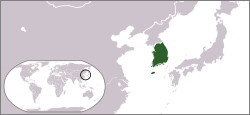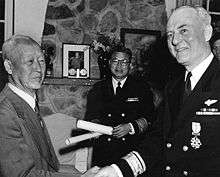First Republic of Korea
The First Republic of Korea (Korean: 제1공화국; RR: Jeil Gonghwaguk; lit. "first republic") was the government of South Korea from August 1948 to April 1960. The First Republic was founded on 15 August 1948 after the transfer from the United States Army Military Government that governed South Korea since the end of Japanese rule in 1945, becoming the first independent capitalist republican government in Korea. Syngman Rhee became the first President of Korea following the May 1948 general election, and the National Assembly in Seoul promulgated South Korea's first constitution in July establishing a democratic presidential system of government.
Republic of Korea 대한민국 大韓民國 | |||||||||||
|---|---|---|---|---|---|---|---|---|---|---|---|
| 1948–1960 | |||||||||||
 | |||||||||||
| Capital | Seoul (1948–1950, 1952–1960) Pusan (1950–1952) | ||||||||||
| Common languages | Korean | ||||||||||
| Religion | Christianity, Confucianism, Buddhism, Korean Shamanism, Cheondoism | ||||||||||
| Government | Unitary authoritarian presidential republic | ||||||||||
| President | |||||||||||
• 1948-1960 | Syngman Rhee | ||||||||||
| Vice President | |||||||||||
• 1948–1951 | Yi Si-yeong | ||||||||||
• 1951–1952 | Kim Seong-su | ||||||||||
• 1952–1956 | Ham Tae-young | ||||||||||
• 1956–1960 | Chang Myon | ||||||||||
| Legislature | National Assembly | ||||||||||
| Historical era | Cold War | ||||||||||
• Proclamation of the Republic of Korea | 15 August 1948 | ||||||||||
| 25 June 1950 – 27 July 1953 | |||||||||||
| 19 April 1960 | |||||||||||
| Currency | Won (1945–1953) Hwan (1953–1962) | ||||||||||
| ISO 3166 code | KR | ||||||||||
| |||||||||||
| Today part of | North Korea South Korea | ||||||||||
As Korean Republic | |||||||||||
| First Republic of Korea | |
 South Korean President Syngman Rhee bestowing a medal on a U.S. Navy admiral | |
| Korean name | |
|---|---|
| Hangul | 제1공화국 |
| Hanja | 第一共和國 |
| Revised Romanization | Jeil Gonghwaguk |
| McCune–Reischauer | Cheil Konghwaguk |
The First Republic claimed sovereignty over the entire Korean Peninsula but only held power south of the 38th parallel until the end of the Korean War in 1953 when the border was modified. The First Republic was characterized by Rhee's authoritarianism and corruption, limited economic development, strong anti-communism, and by the late 1950s growing political instability and public opposition to Rhee. The April Revolution in April 1960 led to Rhee's resignation and the transition to the Second Republic of South Korea.
Politics
Rhee was supported in the elections by the Korea Democratic Party, but didn't include any of its members in his cabinet. In retaliation, the members of the party formed a united opposition Democratic Nationalist Party, and began to advocate a cabinet system which would remove power from the president. This led to a regrouping of the Rhee faction into the Nationalist Party, which later became the Liberal Party, and remained Rhee's base throughout his administration. The country's second parliamentary elections were held on May 30, 1950, and gave the majority of seats to independents.
The South Korean government continued many of the practices of the U.S. military government. This included the brutal repression of leftist activity. The Rhee government continued the harsh military action against the Jeju Uprising. It also crushed military uprisings in Suncheon and Yeosu, which were provoked by orders to sail to Jeju and participate in the crackdown.[1]
Prewar
This government oversaw several prewar massacres, the most notable being the Bodo League massacre where between 100,000[2] and 1,140,000[3] were executed on suspicion of supporting communism.
Korean War
On June 25, 1950, North Korean forces invaded South Korea, starting the Korean War. Led by the United States, a 16-member coalition undertook the first collective action under the umbrella of the U.N. Command (UNC). Oscillating battle lines inflicted a high number of civilian casualties and wrought immense destruction. With the People's Republic of China's entry on behalf of North Korea in 1951, the fighting came to a stalemate close to the original line of demarcation.
Armistice negotiations, initiated in July 1951, finally concluded on July 27, 1953 at Panmunjom, now in the Demilitarized Zone (DMZ). The resulting Armistice Agreement was signed by the North Korean army, Chinese People's Volunteers and the U.S.-led and South Korean-supported United Nations Command. A peace treaty has not been signed up to now. Following the armistice, the South Korean government returned to Seoul on the symbolic date of August 15, 1953.
Postwar events
After the armistice, South Korea experienced political turmoil under years of Syngman Rhee's monarchy, which was ended by student revolt in 1960. Throughout his rule, Rhee sought to take additional steps to cement his control of the government. These began in 1952 (shortly after being elected to a second term), when the government was still based in Busan due to the ongoing war. In May of that year, Rhee pushed through constitutional amendments which made the presidency a directly-elected position. In order to do this, he declared martial law and jailed the members of parliament whom he expected to vote against it. Rhee was subsequently elected by a wide margin. He regained control of parliament in the 1954 elections, and thereupon pushed through an amendment to exempt himself from the eight-year term limit.
Rhee's prospects for reelection during the presidential campaign of 1956 initially seemed dim. Public disillusionment regarding his attempt to seek a third term was growing, and the main opposition candidate Shin Ik-hee drew immense crowds during his campaign. Shin's sudden death while on the campaign trail, however, allowed Rhee to win the presidency with ease. The runner-up of that election, Cho Bong-am of the Progressive Party, was later charged with espionage and executed in 1959.
The events of 1960, known as the April Revolution, were touched off by the violent repression of a student demonstration in Masan on the day of the presidential election, March 15. Initially, these protests were quelled by local police, but they broke out again after the body of a student was found floating in the harbor. Subsequently, nonviolent protests spread to Seoul and throughout the country, and Rhee resigned on April 26.
Education
This period saw explosive growth in education at all levels, even during the turmoil of the Korean War. The First Republic saw the full implementation of an educational system that had been sketched out by the Council for Korean Education under USAMGIK. This education was shaped by the ideal of Hongik Ingan, the person who is a benefit to all, and sought to prepare students for participation in a democratic society. Some contend that this democratic education contributed to the student protests which brought down the authoritarian Rhee government in 1960.[4]
The first Education Law came into force on December 31, 1949.[5] The most important aspect of this was the introduction of universal compulsory education at the primary level. This requirement led to widespread school construction; by the end of the First Republic, primary-school enrollment had topped 95%. In addition, the dual ladder system used by the Japanese occupation government was replaced by a single-ladder system, with 6 years of primary education, 3 of middle-school education, 3 of high-school education, and 4 of college education.
This period also saw the adoption of South Korea's first national curriculum.
Economy
The economy of this period was deeply troubled.
During 1945–1950, United States and South Korean authorities carried out a land reform that retained the institution of private property. They confiscated and redistributed all land held by the Japanese colonial government, Japanese companies, and individual Japanese colonists. The South Korean government carried out a reform whereby South Koreans with large landholdings were obliged to divest most of their land. A new class of independent, family proprietors was created.
International relations
Rhee sought to align his government strongly with the United States, and against both North Korea and Japan.[6] The policy of the First Republic on North Korea, before and after the Korean War, was one of "unification by force."[7] Although some talks towards normalization of relations with Japan took place, they achieved little.[8] Meanwhile, the government took in vast sums of American aid, in amounts sometimes near the total size of the national budget.[9]
On January 18, 1952, Rhee declared South Korean sovereignty over the waters around the Korean Peninsula, in a concept similar to that of today's exclusive economic zones. The maritime demarcation thus drawn up, which Rhee called the "Peace Line", included Liancourt Rocks as South Korean territory.
See also
- History of South Korea
- History of Korea
- List of Korea-related topics
References
Citations
- Cumings, 1997, p. 221.
- "South Korea owns up to brutal past". The Sydney Morning Herald. 2007. Retrieved 2012-09-18.
- "More than 600,000, less than 1,200,000! 최소 60만명, 최대 120만명!" (in Korean). The Hankyoreh Plus. 2001-06-20. Retrieved 21 December 2008.
- Yang, 1999, p. 756.
- Yang, 1999, p. 755.
- Yang, 1999, pp. 194–195.
- Yang, 1999, p. 193.
- Yang, 1999, p. 194.
- Cumings , 1997, p. 255, p. 306.
Sources
- Cumings, Bruce (1997). Korea's place in the sun. New York: W.W. Norton. ISBN 0-393-31681-5.
- Lee, Ki-baek (1984). A new history of Korea. tr. by E.W. Wagner & E.J. Shultz (rev. ed.). Seoul: Ilchogak. ISBN 89-337-0204-0.
- Nahm, Andrew C. (1996). Korea: A history of the Korean people (2nd ed.). Seoul: Hollym. ISBN 1-56591-070-2.
- Yang, Sung Chul (1999). The North and South Korean political systems: A comparative analysis (rev. ed.). Seoul: Hollym. ISBN 1-56591-105-9.
- Yonhap News Agency (2004). Korea Annual 2004. Seoul: Yonhap News Agency. ISBN 89-7433-070-9.
.svg.png)
.svg.png)
.svg.png)